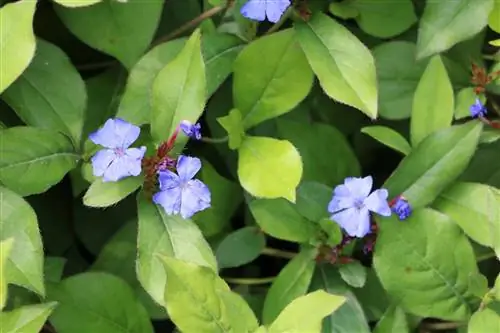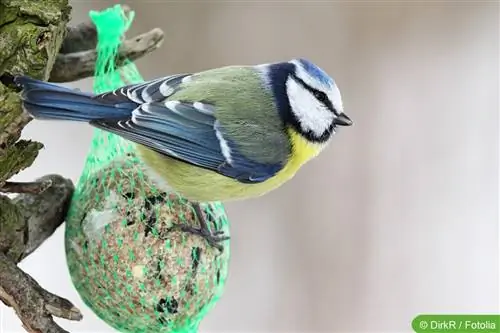- Author admin [email protected].
- Public 2023-12-17 03:39.
- Last modified 2025-01-24 12:45.
Of all the plumbago species, Ceratostigma plumbaginoides is most commonly cultivated in our gardens. The perennial is ideal as a ground cover and adapts to many different living conditions. Due to its lateral runners, the blue leadwort spreads rather slowly. In groups it forms wonderful cushions, but never becomes annoying or even overgrown. This makes it the ideal plant for perennial beds, woody edges or rock gardens. The leadwort reacts sensitively to wetness in winter, otherwise it is rather easy to care for.
Profile
- Botanical name: Ceratostigma plumbaginoides
- Other names: Chinese Leadwort, Creeping Hornscar, Gentian Leadwort
- belongs to the Plumbaginaceae family
- deciduous herbaceous perennial, ground cover
- Growth height: 20-30 cm, carpet-like
- Leaves: lanceolate-shaped, red autumn color
- Flowers: sky blue, stalk-shaped (wheel-shaped) flowers from August to October
- perennial
- hardy
Location
Seven of the eight leadwort species come from Asia, only one species occurs in East Africa. The blue leadwort grows in western China both on forest floors and at the edges of forests, but also occurs in open spaces. In the garden it prefers a sunny to partially shaded location and can cope with almost all normal garden soils that are well drained. All locations that are exposed to the sun for at least four hours are favorable. It develops well in shady areas, but flowers slightly less. The blue leadwort has many uses in the garden. It tolerates living areas on the edges of trees or under sparse trees, gravel areas, stone beds and steppe gardens and even grows without any problems on the tops of walls or in dry stone walls. Leadwort is also suitable for planting dry embankments as it protects the soil from erosion.
- Light requirements: sunny to partially shaded
- normal garden soil, water-permeable
- slightly humus, also stony or rocky
- sandy loamy
- neutral to calcareous (7-9)
- dry to slightly fresh (moist) soil
- Heat loving, resistant to heat
Tip:
Wonderful companion for roses, spurge (Euphorbia), cinquefoil (Potentilla), summer daisies (Leucanthemum maximum), Japanese sedge (Carex morrowii) and ground squirrel (Stachys).
Plants
The blue leadwort works well in combination with spring bloomers that are colored to match the blue flowers (yellow, orange). The ground cover is also well suited for beds in which tall grass forms the background. Small perennials that bloom early in spring are not a problem as neighbors, as the blue leadwort only sprouts its leaves very late (May). However, all other low-growing plants are overgrown by the competitive plant over time and die due to lack of space and light. A Chinese leadwort is very easy to care for and adaptable, but if the soil is heavy, sand and grit should be incorporated before planting so that waterlogging never occurs.
- Time: Spring from April/May
- Planting distance: 25-30 cm
- plant in larger groups (at least 5)
- impressive in colonies of 20-50 individual plants
- about 8 to 15 plants per square meter
- the drier and rockier the soil, the more plants are necessary for the area
A leadwort is also very decorative in flower pots on the terrace or balcony. It is well suited for a combination with bulbous flowers such as tulips or daffodils, as it only sprouts when the early bloomers have already withered.
Tip:
Young plants are somewhat sensitive to late frosts in spring, so replanting is not recommended until May.
Watering and fertilizing
The gentian leadwort is a drought-tolerant ground cover that almost never needs additional watering in humid, moist forest edges. On very sandy or stony surfaces, regular watering is necessary if there is extreme heat or long periods of drought in summer. However, the leadwort should never be watered in full sunlight (midday). Early morning hours or later in the evening are more suitable. The perennials cannot tolerate waterlogging, so the soil should be well drained so that rain or irrigation water can always drain away easily. In spring it is recommended to add fertilizer with compost, horn shavings or horn meal. These natural long-term fertilizers then provide the plants with all the necessary nutrients throughout the year.
Tip:
Don't worry if there are still no new shoots on the blue leadwort in May. The plant sprouts very late, sometimes not until June!
Propagation
The leadwort reproduces both via seeds and underground runners that develop on the side of the main plant. These runners can easily be cut off with a sharp knife in the fall when some roots have already formed. Then you simply put them back in the ground somewhere else and water them well. For he althy, older plants, propagation by cuttings is another method of propagating the plant vegetatively.
- Time: Spring to Summer
- cut head cuttings (without flowers) after sprouting
- (Head cuttings are shoot tips with several leaves)
- Length: 5-15 cm
- remove lower leaves
- leave about 3-5 sheets
- scrape the upper layer on the lower part of the stem with a sharp knife (2 cm)
- insert into moist potting soil or cactus soil
- Put over plastic film
- place brightly (without direct sun)
After rooting - which can be recognized by the first new shoot tips - the plastic bag is removed and the plant is watered normally. In late summer (or next spring) the leadwort can then go outdoors. If you are staying indoors over the winter: keep it cool and bright.
Cutting and overwintering
The Chinese leadwort is not cut during the year. In principle, the shoots can be cut off close to the ground in autumn, as they cannot survive the winter anyway. However, it is better to leave the leaves over the winter and only cut them back in early spring. This has two advantages: On the one hand, the beautiful deep red autumn foliage decorates the garden for a long time, and secondly, the leaves (even if they are wilted or rotten) serve as natural winter protection against frost. Ceratostigma plumbaginoides are frost hardy down to temperatures of -23 °C. The gentian leadwort (like other perennials) must never be cut back too early, as the plant still has to store reserves for the winter in the tubers or roots. Earliest time to prune: When the foliage begins to slowly rot or dry out. Before the leadwort sprouts again, it can simply be cut off about 3 cm above the ground level.
Tip:
If you cut back the shoots in autumn, you should protect the roots from frost with some leaves or brushwood.
Likelihood of confusion
Ceratostigma plumbaginoides is easily confused with Plumbago auriculata and Plumbago indica - both plumbago species that cannot tolerate frost and are therefore not allowed to spend the winter outdoors.
Diseases and pests
The Chinese leadwort is a robust perennial. Pest or disease problems are very rare. In cold, damp spring months, the plant, which is not sensitive to snails, can sometimes become infected with powdery mildew. In these cases, infected plant parts must be removed promptly and disposed of with household waste.
What you should know about blue leadwort in brief
- If you want to bring a touch of Asia into your own garden, you are well served with this robust and easy-care perennial.
- The blue leadwort is one of the most beautiful ground cover plants in partially shaded border beds or in rock gardens.
- From August onwards it produces rare blue flowers for woody perennials, which form a strong contrast to its red autumn foliage from autumn onwards.
Tip:
The leadwort Ceratostigma plumbaginoides is often confused with the leadwort, which grows as a climbing plant. The one described here is a ground cover that does not come from Africa, but from Asia.
- The location for the Chinese leadwort should be in full sun to partial shade. He likes a warm place.
- As the branches break easily, a place protected from the wind is recommended.
- The soil should be moderately dry, slightly calcareous, poor and permeable.
- If the soil is heavy, you can mix in some sand to avoid waterlogging. The Leadwort also likes mineral soils.
- We water regularly in the warm seasons, but not too much. Leadwort is drought tolerant.
- Waterlogging is not tolerated, nor is winter wetness.
- In the spring before budding, the leadwort should be cut off about 3 cm above the ground.
- Dried leaves should be removed as they promote the development of fungi.
- In winter, leadwort needs winter protection, especially in rough locations. Brushwood is suitable for this.
- The leadwort is propagated by sowing or cuttings. But it also spreads quickly through runners and can really grow.
- The leadwort, which grows as a climbing plant, likes a lot of sun, as the plant comes from southern Africa. A place protected from the wind is ideal.
- In summer the plant needs enough water. However, waterlogging must be avoided at all costs.
- Weekly fertilizer application is recommended from April to September.
Tip:
The leadwort grows very quickly. It is important that the tips are always trimmed so that it not only grows in length but also branches out. The faded, sticky calyxes must be removed regularly. It is beneficial if you give the leadwort a climbing or trellis structure, otherwise the growth habit can sometimes take on very strange shapes.
- The leadwort is not hardy, but can be overwintered as a potted plant in the house.
- Before putting away, all branches should be cut back to a third or even half. This delays flowering slightly.
- The leadwort overwinters best in a bright room at temperatures between 8 and 12 ºC.
- It is also possible to place it in a relatively dark room, at temperatures between 5 and 8 ºC. However, the plant loses its leaves.
- Only a little is watered, just enough so that the bale does not dry out.
- If the leadwort only has to be thinned out in the spring if it overwinteres in a bright area.






